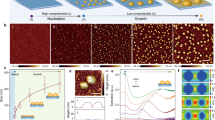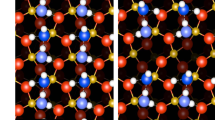Abstract
Solid–liquid–gas reactions are ubiquitous and are encountered in both nature and industrial processes1,2,3,4. A comprehensive description of gas transport in liquid and following reactions at the solid–liquid–gas interface, which is substantial in regard to achieving enhanced triple-phase reactions, remains unavailable. Here, we report a real-time observation of the accelerated etching of gold nanorods with oxygen nanobubbles in aqueous hydrobromic acid using liquid-cell transmission electron microscopy. Our observations reveal that when an oxygen nanobubble is close to a nanorod below the critical distance (~1 nm), the local etching rate is significantly enhanced by over one order of magnitude. Molecular dynamics simulation results show that the strong attractive van der Waals interaction between the gold nanorod and oxygen molecules facilitates the transport of oxygen through the thin liquid layer to the gold surface and thus plays a crucial role in increasing the etching rate. This result sheds light on the rational design of solid–liquid–gas reactions for enhanced activities.
This is a preview of subscription content, access via your institution
Access options
Access Nature and 54 other Nature Portfolio journals
Get Nature+, our best-value online-access subscription
$29.99 / 30 days
cancel any time
Subscribe to this journal
Receive 12 print issues and online access
$259.00 per year
only $21.58 per issue
Buy this article
- Purchase on Springer Link
- Instant access to full article PDF
Prices may be subject to local taxes which are calculated during checkout




Similar content being viewed by others
Data availability
The data that support the findings of this study are available from the corresponding authors upon request.
References
Snyder, J., Fujita, T., Chen, M. W. & Erlebacher, J. Oxygen reduction in nanoporous metal-ionic liquid composite electrocatalysts. Nat. Mater. 9, 904–907 (2010).
Irvine, J. T. S. et al. Evolution of the electrochemical interface in high-temperature fuel cells and electrolysers. Nat. Energy 1, 15014 (2016).
Qiao, M. & Titirici, M.-M. Engineering the interface of carbon electrocatalysts at the triple point for enhanced oxygen reduction reaction. Chem. Eur. J. 24, 18374–18384 (2018).
Tang, C., Wang, H.-F. & Zhang, Q. Multiscale principles to boost reactivity in gas-involving energy electrocatalysis. Acc. Chem. Res. 51, 881–889 (2018).
Chen, P., Guo, M., Han, W., Wang, Z. & Wang, C. Study of corrosion evolution of carbon steel exposed to an industrial atmosphere. Corros. Eng. Sci. Technol. 54, 241–248 (2019).
Bu, F. R., Li, J. N. & Huang, H. L. Effects of electrolyte thickness, chloride ion concentration, and an external direct current electric field on corrosion behaviour of silver under a thin electrolyte layer. Corros. Eng. Sci. Technol. 54, 143–153 (2018).
Zhu, Y. P., Guo, C., Zheng, Y. & Qiao, S.-Z. Surface and interface engineering of noble-metal-free electrocatalysts for efficient energy conversion processes. Acc. Chem. Res. 50, 915–923 (2017).
Li, J. et al. Breathing-mimicking electrocatalysis for oxygen evolution and reduction. Joule 3, 557–569 (2019).
Liu, Z. et al. Superaerophilic carbon-nanotube-array electrode for high-performance oxygen reduction reaction. Adv. Mater. 28, 7155–7161 (2016).
Seh, Z. W. et al. Combining theory and experiment in electrocatalysis: insights into materials design. Science 355, eaad4998 (2017).
Liu, M., Zhao, Z., Duan, X. & Huang, Y. Nanoscale structure design for high-performance Pt-Based ORR catalysts. Adv. Mater. 31, e1802234 (2019).
Qiao, M. et al. Oxygenophilic ionic liquids promote the oxygen reduction reaction in Pt-free carbon electrocatalysts. Mater. Horiz. 4, 895–899 (2017).
Lu, Q. Highly porous non-precious bimetallic electrocatalysts for efficient hydrogen evolution. Nat. Commun. 6, 6567 (2015).
Liu, Z., Sheng, X., Wang, D. & Feng, X. Efficient hydrogen peroxide generation utilizing photocatalytic oxygen reduction at a triphase interface. iScience 17, 67–73 (2019).
Hutzler, A. et al. In situ liquid cell TEM studies on etching and growth mechanisms of gold nanoparticles at a solid-liquid-gas interface. Adv. Mater. Interfaces 6, 1901027 (2019).
Sun, J. et al. Liquid-like pseudoelasticity of sub-10-nm crystalline silver particles. Nat. Mater. 13, 1007–1012 (2014).
Zhou, Y. et al. In situ observation of atomic-scale stability limit of Cu nanoparticles. Mater. Today Nano. 4, 32–37 (2018).
Xu, H. et al. Dynamic structure-properties characterization and manipulation in advanced nanodevices. Mater. Today Nano 7, 100042 (2019).
Yang, J. et al. Formation of two-dimensional transition metal oxide nanosheets with nanoparticles as intermediates. Nat. Mater. 18, 970–976 (2019).
Shin, D. et al. Growth dynamics and gas transport mechanism of nanobubbles in graphene liquid cells. Nat. Commun. 6, 6068 (2015).
Zheng, H. et al. Observation of single colloidal platinum nanocrystal growth trajectories. Science 324, 1309–1312 (2009).
Ye, X. et al. Single-particle mapping of nonequilibrium nanocrystal transformations. Science 354, 874–877 (2016).
Zhu, C. et al. In-situ liquid cell transmission electron microscopy investigation on oriented attachment of gold nanoparticles. Nat. Commun. 9, 421 (2018).
Ou, Z., Wang, Z., Luo, B., Luijten, E. & Chen, Q. Kinetic pathways of crystallization at the nanoscale. Nat. Mater. 19, 450–455 (2020).
Paul, J. M. et al. Calcium carbonate nucleation driven by ion binding in a biomimetic matrix revealed by in situ electron microscopy. Nat. Mater. 14, 394–399 (2015).
Xu, T. & Sun, L. Investigation on material behavior in liquid by in situ TEM. Superlattices Microstruct. 99, 24–34 (2016).
Tsung, C.-K. et al. Selective shortening of single-crystalline gold nanorods by mild oxidation. J. Am. Chem. Soc. 128, 5352–5353 (2006).
Jian, Y. et al. In situ study of oxidative etching of palladium nanocrystals by liquid cell electron microscopy. Nano Lett. 14, 3761–3765 (2014).
Woehl, T. J. & Abellan, P. Defining the radiation chemistry during liquid cell electron microscopy to enable visualization of nanomaterial growth and degradation dynamics. J. Microsc. 265, 135–147 (2017).
Schneider, N. M. et al. Electron-water interactions and implications for liquid cell electron microscopy. J. Phys. Chem. C Nanomater. Interfaces 118, 22373–22382 (2014).
Hauwiller, M. R. et al. Gold nanocrystal etching as a means of probing the dynamic chemical environment in graphene liquid cell electron microscopy. J. Am. Chem. Soc. 141, 4428–4437 (2019).
Wang, W. et al. Controlled oxidative etching of gold nanorods revealed through in-situ liquid cell electron microscopy. Sci. China Mater. 63, 2599–2605 (2020).
Nirmalkar, N., Pacek, A. W. & Barigou, M. Interpreting the interfacial and colloidal stability of bulk nanobubbles. Soft Matter 14, 9643–9656 (2018).
Ye, X., Zheng, C., Chen, J., Gao, Y. & Murray, C. B. Using binary surfactant mixtures to simultaneously improve the dimensional tunability and monodispersity in the seeded growth of gold nanorods. Nano Lett. 13, 765–771 (2013).
Jungjohann, K. L., Evans, J. E., Aguiar, J. A., Arslan, I. & Browning, N. D. Atomic-scale imaging and spectroscopy for in situ liquid scanning transmission electron microscopy. Microsc. Microanal. 18, 621–627 (2012).
Aronova, M. A., Sousa, A. A. & Leapman, R. D. EELS characterization of radiolytic products in frozen samples. Micron 42, 252–256 (2011).
Laffon, C., Lacombe, S., Bournel, F. & Parent, P. Radiation effects in water ice: a near-edge X-ray absorption fine structure study. J. Chem. Phys. 125, 204714 (2006).
Aqvist, J. Ion-water interaction potentials derived from free energy perturbation simulations. J. Phys. Chem. 94, 8021–8024 (1990).
Fang, G. & Chen, J. Hindered gas transport through an aqueous salt solution interface. J. Phys. Chem. C Nanomater. Interfaces 122, 20774–20780 (2018).
Berger, M. J. et al. Stopping-power and range tables for electrons, protons, and helium ions. NIST Physical Measurement Laboratory https://doi.org/10.18434/T4NC7P (2017).
Acknowledgements
This work is especially for the 120th anniversary of Southeast University. We thank H. Zhang and H.-T. Zhang (SEU-FEI Nano-Pico Center, Southeast University) for support and useful discussions. The work at Lawrence Berkeley National Laboratory was supported by the US Department of Energy, Office of Science, Office of Basic Energy Sciences, Materials Sciences and Engineering Division under contract no. DE-AC02-05-CH11231 within the in situ TEM programme (no. KC22ZH). The work at Southeast University was supported by the National Natural Science Foundation of China (grant nos. 51420105003, 11327901, 61601116 and 61974021) and the National Science Fund for Distinguished Young Scholars (grant no. 11525415). J.C. thanks the Natural Science Foundation of Shanghai (grant no. 14ZR1448100, 19ZR1463200), and the Shanghai Supercomputer Center of China and Big Data Science Center of Shanghai Synchrotron Radiation Facility. W.W. thanks the China Scholarship Council (no. 201806090114) for financial support.
Author information
Authors and Affiliations
Contributions
W.W., H.F., H.Z. and L.S. conceived and designed the experiments. W.W. and T.X. performed the experiments. J.C., H.M., J.Y. and H.F. developed the simulations. J.S., H.D. and Q.Z. participated in discussions and data analysis. Z.G. and T.B. synthesized samples. L.S. supervised the project and revised the paper with H.Z. and H.F. The manuscript contains contributions by all authors. All authors gave approval to the final version of the manuscript.
Corresponding authors
Ethics declarations
Competing interests
The authors declare no competing interests.
Peer review
Peer review information
Nature Materials thanks Abhaya Datye and the other, anonymous, reviewer(s) for their contribution to the peer review of this work.
Additional information
Publisher’s note Springer Nature remains neutral with regard to jurisdictional claims in published maps and institutional affiliations.
Supplementary information
Supplementary Information
Supplementary Figs. 1–20.
Supplementary Video 1
Uniform etching of a Au nanorod without nanobubbles; electron dose rate was 780 e− Å−2 s−1.
Supplementary Video 2
Etching of a Au nanorod with nanobubbles at the side; electron dose rate was 370 e− Å−2 s−1.
Supplementary Video 3
Etching of a Au nanorod with a nanobubble at one end; electron dose rate was 370 e− Å−2 s−1.
Supplementary Video 4
Etching of a Au nanorod with moving nanobubbles; electron dose rate was 200 e− Å−2 s−1.
Rights and permissions
About this article
Cite this article
Wang, W., Xu, T., Chen, J. et al. Solid–liquid–gas reaction accelerated by gas molecule tunnelling-like effect. Nat. Mater. 21, 859–863 (2022). https://doi.org/10.1038/s41563-022-01261-x
Received:
Accepted:
Published:
Issue Date:
DOI: https://doi.org/10.1038/s41563-022-01261-x
This article is cited by
-
Hierarchical conductive metal-organic framework films enabling efficient interfacial mass transfer
Nature Communications (2023)
-
Revisited electrochemical gas evolution reactions from the perspective of gas bubbles
Nano Research (2023)



